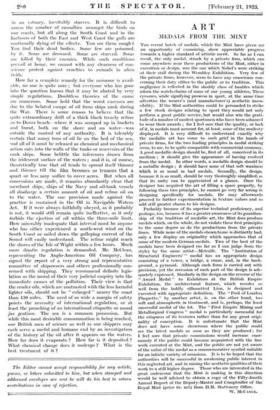ART
MEDALS FROM THE MINT
THE recent batch of medals, which the Mint have given me an opportunity of examining, show appreciable progress towards a higher standard of artistic merit. So far as I can recall, the only medal, struck by a private firm, which can come anywhere near these productions of the Mint, either in execution or design, was the one which Nobel's were striking at their stall during the Wembley Exhibition. Very few of the private firms, however, seem to have any conscience con- cerning their duty either to the public or to tradition. This negligence is reflected in the shoddy class of baubles which adorn the watch-chains of some of our young athletes. These eyesores, while signifying prowess in sport, at the same time advertise the wearer's (and manufacturer's) aesthetic insen- sibility. If the Mint authorities could be persuaded to strike a few stock designs relating to sport they would not only perform a great public service, but would also win the grati- tude of a number of modest sportsmen who have been ashamed to wear their awards ; for I feel sure that the quality, or lack of it, in medals must account for, at least, some of the modesty displayed. It is very difficult to understand exactly why the medallic art has come to such grief in the hands of private firms, for the two leading principles in medal striking seem, to me, to be quite compatible with commercial economy. A good medallic design should be, first of all, conceived in its medium ; it should give the appearance of having evolved from the medal. In other words, a medallic design should be a metallic design ; it should have none of that soft waxiness which is so usual in bad medals. Secondly, the design, because it is so small, should be very thoroughly simplified, so that its unity can be appreciated at a glance. Once the designer has acquired the art of filling a space properly, by following these two principles, he cannot go very far wrong in designing specifically for medals. He may afterwards proceed to further experimentation in texture values and su add still greater charm to his designs.
Probably because of its superior technical proficiency, and perhaps, too, because it has a greater awareness of its guardian- ship of the tradition of medallic art, the Mint does produce medals which, on the whole, do not violate these first principles to the same degree as do the productions from the private firms. While none of the medals shown to me is distinctly bad, only a few display an originality which approaches that of some of the modern German medals. Two of the best of the medals have been designed (so far as I can judge from the style) by the same artist—Metcalfe. The "Institution of Structural Engineers' " medal has an appropriate design consisting of a tower, a bridge, a crane, and, in the back- ground, a pyramid. Although each form is carried out with precision, yet the recession of each part of the design js ade-' quately expressed. Similarly in the design on the reverse of the " Award Medal " to Exhibitors at the British Empire Exhibition, the architectural feature, which recedes so well from the boldly silhouetted Lion, is designed and executed with appropriate definition. The "Pool of London Plaquette," by another artist, is, on the other hand, too soft and atmospheric in treatment, and is, perhaps, the least successful medal of the lot. The "First Empire Mining and Metallurgical Congress " medal is particularly successful for the crispness of its textures rather than for any great origi- nality of conception. It is unfortunate that the Mint does not have some showroom where the public could see the latest medals as soon as they are produced ; for I feel sure that private commissions would increase enor- mously if the public could become acquainted with the fine work executed at the Mint, and the public are not yet aware of the value of the medal as a commemorative symbol suitable for an infinite variety of occasions. It is to be hoped that the authorities will be successful in awakening public interest in this neglected art, and in raising the aesthetic qualities of their work to a still higher degree. Those who are interested in the great endeavour that the Mint is making in this direction would be well advised to obtain a copy of the Fifty-fourth Annual Report of the Deputy-Master and. Comptroller of the Royal Mint (price 6s. net) from H.M. Stationery Office.
W. MCCANCE.










































 Previous page
Previous page